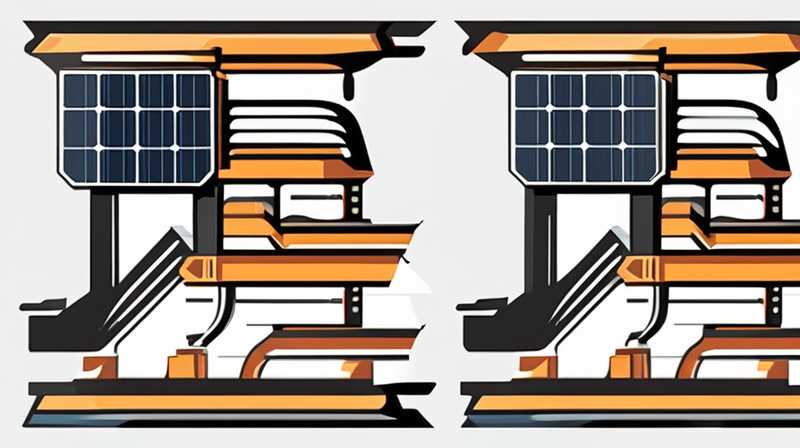
To successfully install a solar light head, one must follow a series of crucial steps that ensure efficiency and functionality. 1. Selecting the appropriate location for installation, is vital, as the solar panel needs ample sunlight exposure throughout the day. 2. Properly securing the light head to a sturdy surface, is necessary to withstand weather conditions. 3. Connecting the solar light head components accurately should be performed to guarantee uninterrupted power flow. 4. Testing the functionality after installation allows for immediate identification of any issues. A particularly significant consideration is the proper positioning of the solar light head, which impacts the overall performance and efficiency. Ensuring that the solar panel faces south (in the Northern Hemisphere) enhances sunlight absorption, thereby increasing the charge during daylight hours.
1. SELECTING THE APPROPRIATE LOCATION
Choosing the optimal spot for your solar light head can dramatically affect its performance and durability. Finding a location with unimpeded access to sunlight, free from overshadowing structures or foliage, is essential. This ensures maximum solar energy absorption. Without adequate sunlight, the efficiency of the solar panel diminishes, leading to underperformance of the lighting system.
In addition to sunlight access, consider the landscape where you plan to install your lighting system. Different terrains, such as slopes or flat surfaces, may affect the installation process. A sturdy surface that can support the weight and size of the solar light is crucial for its stability. For example, flat, even ground can provide a stable foundation, while more dynamic landscapes may require additional supports or modifications for secure installation.
2. SECURING THE LIGHT HEAD PROPERLY
Once a location has been identified, the next step involves securely anchoring the solar light head. Using a reliable mounting bracket is vital for stability. Most solar lights come with specific mounting kits designed for the model, and it is highly beneficial to utilize these components as they often contain all necessary tools and hardware. Ensure that the mounting bracket is aligned correctly to avoid an unstable installation that could lead to malfunctions.
Moreover, it is necessary to assess external factors, such as wind and storm exposure. If the installation site is prone to extreme weather conditions, it may warrant an enhanced securing mechanism, such as concrete footing or additional anchoring methods. Wind tested designs can provide additional peace of mind that your light will remain intact and functional regardless of weather changes.
3. CONNECTING SOLAR LIGHT HEAD COMPONENTS
Accurate connection of various components of the solar light system is essential to ensure that it operates seamlessly. Each component needs to be connected following specific guidelines often outlined in the manufacturer’s manual. Emphasizing the importance of matching the color-coded cables for positive and negative terminals can prevent potential short circuits. Misconnections may lead to damage or malfunction, wasting investment and time.
In the installation process, grounding cables should not be overlooked. Proper grounding minimizes the risk of damaging the light from electrical surges, especially in regions prone to thunderstorms. Regular maintenance checks should also be scheduled to ensure cables remain secure and intact over time. If any wear or damage appears, replacements should be prioritized to maintain optimal functionality.
4. TESTING FUNCTIONALITY AFTER INSTALLATION
Once the installation is completed, it’s essential to conduct thorough testing. Verifying that the light head illuminates effectively is paramount. This testing should occur at dusk or in low-light conditions to confirm the light’s functionality and brightness. If issues arise, revisiting the connections and settings may be necessary.
Furthermore, observing the charge duration can provide insight into the system’s efficiency. If the light does not achieve the expected duration, re-evaluating the location or the solar panel’s angle may be warranted. Continuous monitoring for the first few days after installation can quickly highlight any issues, allowing for timely adjustments or repairs to ensure consistent performance.
FAQs
WHAT TO CONSIDER WHEN CHOOSING A SOLAR LIGHT HEAD?
When selecting a solar light head, consider the power output, duration of illumination, and the design of the solar panel. Ensure the wattage aligns with your lighting needs. Evaluate the battery capacity, as this dictates how long the light stays illuminated after sunset. Design options should complement your aesthetics while also providing functionality, impacting the efficiency.
HOW LONG DOES IT TAKE TO INSTALL A SOLAR LIGHT HEAD?
The installation time for a solar light head typically ranges from 30 minutes to a couple of hours. The duration may vary based on several factors, including complexity of connections, site preparation, and individual experience with solar installation. Proper planning, however, can streamline the process considerably. Pre-assembled models can significantly reduce installation time, as fewer connections are necessary.
CAN SOLAR LIGHT HEADS WORK ON CLOUDY DAYS?
Yes, solar light heads can operate on cloudy days, although their performance may reduce. Solar panels can still collect diffuse sunlight, albeit at less efficiency compared to direct sunlight. Battery quality and capacity also play crucial roles. Using high-efficiency solar panels ensures better performance in less-than-ideal weather conditions.
COMPREHENSIVE FINAL REMARKS
Incorporating a solar light head represents a significant leap towards sustainable energy solutions. Ensuring meticulous installation fosters energy independence while reducing reliance on conventional power sources. The entire process, from location selection to secure connections and functionality testing, emphasizes technological sophistication and environmental stewardship. Each step holds its own importance, but collectively, they contribute to a solar lighting system’s overall success.
The advantages extend beyond mere illumination; they encompass environmental impact, energy savings, and potential enhancements to residential and commercial landscapes. By reducing light pollution and promoting energy efficiency, solar lighting becomes a pivotal component of eco-friendly design schematics.
Understanding how to externally interact with this technology through proper installation can transform spaces while fostering a positive ecological impact. As innovation continues to advance solar technology, awareness and expertise in installation processes become essential. The outcome is not just functional lighting, but an opportunity for individuals and communities to engage in greener practices that benefit society as a whole.
Original article by NenPower, If reposted, please credit the source: https://nenpower.com/blog/how-to-install-solar-light-head/


